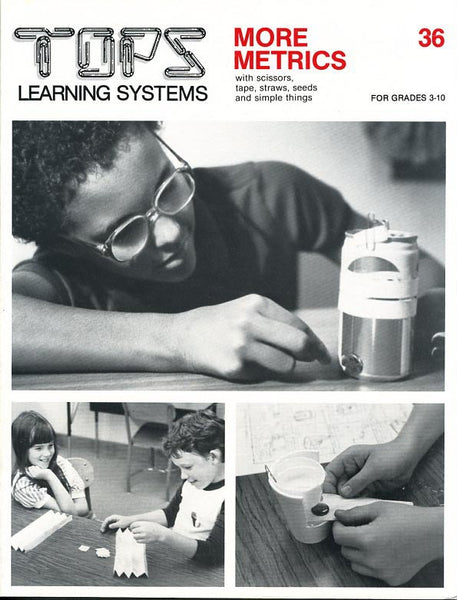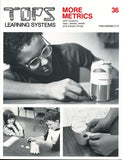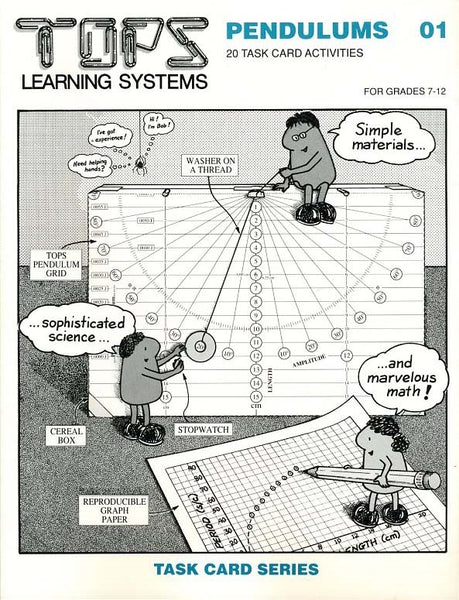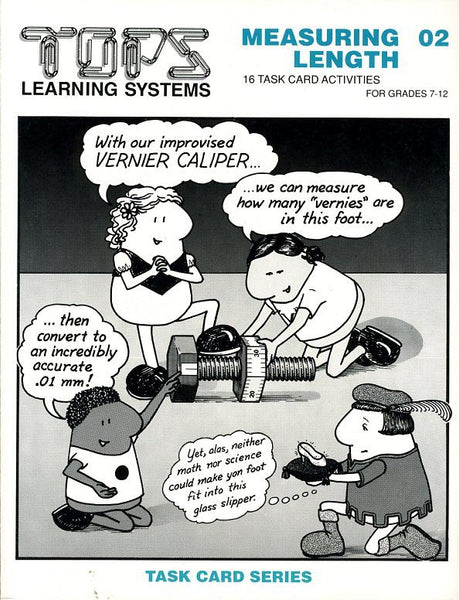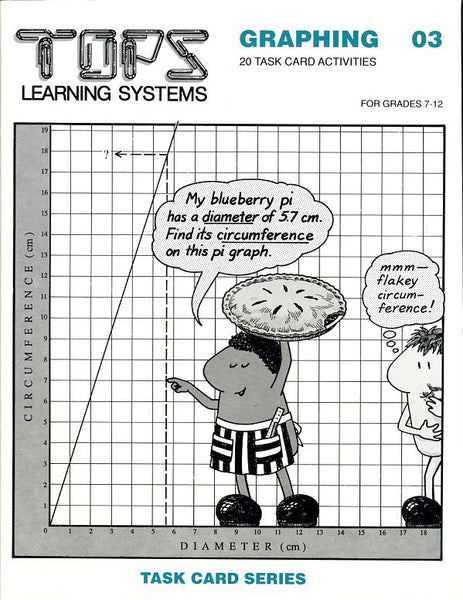#36 More Metrics (grades 6-10)
Regular price $23.95
Soft-bound, 80 page book, 20 reproducible activity sheets, full teaching notes.
How much is a hectoliter? Who cares? This book teaches only those metric units that are important - meters, grams and liters - plus 6 useful derivatives. Play Metric Rummy. Build an amazingly sensitive straw balance sensitive to just 1 milligram. Learn to estimate to the last uncertain digit for measuring accuracy.
More Information – click any of the tabs below to learn more about this title
Click here for a complete list of materials and convenient shopping.
Key: (1st/2nd/3rd) denote needed quantities: (1st) enough for 1 student doing all activities; (2nd) enough for 30 students working in 10 lab groups all self-paced; (3rd) enough for 30 students working in 10 lab groups, all doing the same lesson. Starred* items may be purchased below.
1/30/30: sheets of lined notebook paper
1/20/30: scissors
* 1/30/30: wooden spring-action clothespins
* 1/1/1: roll masking tape
* 1/1/1: box paper clips
1/30/30: soda pop cans
* 1/10/10: rolls clear tape
* 1/1/1: spool thread
2/50/60: pennies
2/50/60: index cards, 3x5 inch
1/1/1: piece of butcher paper for marking body measurements against a wall (optional)
* 4/150/150: plastic soda straws
* 2/60/60: straight pins
1/1/1: packages each of pinto beans, popcorn, lentils, long-grained white rice
1/20/30: staples
3/90/90: disposable cups, paper or styrofoam, 6 ounces or more
1/1/1: water source
1/4/10: teaspoons with approximate standard measuring capacity
* 1/1/1: sheet aluminum foil
1/1/1: bottle plain uncoated aspirin, 5 grain tablets
several: packages of candy, nuts, raisins or other treat with uniform small mass
1/30/30: sheets of lined notebook paper
1/20/30: scissors
* 1/30/30: wooden spring-action clothespins
* 1/1/1: roll masking tape
* 1/1/1: box paper clips
1/30/30: soda pop cans
* 1/10/10: rolls clear tape
* 1/1/1: spool thread
2/50/60: pennies
2/50/60: index cards, 3x5 inch
1/1/1: piece of butcher paper for marking body measurements against a wall (optional)
* 4/150/150: plastic soda straws
* 2/60/60: straight pins
1/1/1: packages each of pinto beans, popcorn, lentils, long-grained white rice
1/20/30: staples
3/90/90: disposable cups, paper or styrofoam, 6 ounces or more
1/1/1: water source
1/4/10: teaspoons with approximate standard measuring capacity
* 1/1/1: sheet aluminum foil
1/1/1: bottle plain uncoated aspirin, 5 grain tablets
several: packages of candy, nuts, raisins or other treat with uniform small mass
- Lesson 1: To understand metric prefixes as simple multiples of ten. To estimate numbers by comparing lengths.
- Lesson 2: To visualize how metric units fit together as multiples of 10. To practice expressing one measure in terms of another.
- Lesson 3: To become familiar with 42 important interrelated facts about metric volume, mass and length.
- Lesson 4: To firmly link metric units with common conversion factors and concrete images.
- Lesson 5: To memorize metric relationships in a fun way.
- Lesson 6: To learn how to read a ruler accurately, estimating the last digit.
- Lesson 7: To distinguish between certain figures and uncertain figures. To appreciate that no measurement is exact.
- Lesson 8: To practice estimating between centimeter intervals. To check your accuracy with a millimeter scale.
- Lesson 9: To accurately locate millimeters, centimeters, and meters with a hairline on a metric scale.
- Lesson 10: To agree with a friend, within acceptable limits of uncertainty, where the hairline crosses a scale.
- Lesson 11: To practice measuring accurately with a ruler. To recognize that estimating is necessary no matter how accurate the ruler.
- Lesson 12: To practice measuring physical objects with a meter tape. To estimate the last digit.
- Lesson 13: To discover basic body proportions by making accurate measurements with a meter tape. To appreciate that body measure is not standard.
- Lesson 14: To improvise a single-arm balance beam, accurate to a milligram.
- Lesson 15: To learn to operate a microbalance. To compare the masses of small objects, ordering them from highest to heaviest.
- Lesson 16: To make a set of milligram weights for the microbalance. To use them to find the masses of small objects.
- Lesson 17: To graph how the mass of seeds increases in direct proportion to their numbers. To learn to draw and interpret graphs.
- Lesson 18: To construct a dripper that dispenses uniform water drops. To confirm that a teaspoon holds 5 mL of liquid.
- Lesson 19: To find the mass of a uniform water drop. To compare the volume of water a penny can hold with the volume contained in a centimeter cube.
- Lesson 20: To use a microbalance to determine if aspirin tablets are 100% pure. To estimate total quantity based on the mass of a few.
We encourage improvisation - it's one of the main goals of our hands-on approach! You and your students might invent a simpler, sturdier or more accurate system; might ask a better question; might design a better extension. Hooray for ingenuity! When this occurs, we'd love to hear about it and share it with other educators.
National Science Education Standards (NRC 1996)
Teachers of science...
A: ...plan an inquiry-based science program. (p. 30)
B: ...guide and facilitate learning. (p. 32)
C: ...engage in ongoing assessment of their teaching and of student learning. (p. 37)
D: ...design and manage learning environments that provide students with the time, space, and resources needed for learning science. (p. 43)
• Represent a central event or phenomenon in the natural world.
• Represent a central scientific idea and organizing principle.
• Have rich explanatory power.
• Guide fruitful investigations.
• Apply to situations and contexts common to everyday experiences.
• Can be linked to meaningful learning experiences.
• Are developmentally appropriate for students at the grade level specified.
Core Concepts/Processes: Reach easy familiarity with commonly used metric units - meters, grams and liters - plus six commonly used derivatives. • Visualize how metric units would all fit together on a giant kilometer ruler.
Core Inquiries: Learn to measure accurately by recording all certain figures, plus one uncertain figure. • Read scales independently and compare significant figures.
Core Content: Construct a microbalance using a drinking straw. Cut paper squares to weigh small objects in micrograms.
TEACHING Standards
These 20 activity sheets promote excellence in science teaching by these NSES criteria:Teachers of science...
A: ...plan an inquiry-based science program. (p. 30)
B: ...guide and facilitate learning. (p. 32)
C: ...engage in ongoing assessment of their teaching and of student learning. (p. 37)
D: ...design and manage learning environments that provide students with the time, space, and resources needed for learning science. (p. 43)
CONTENT Standards
These 20 activity sheets contain fundamental content as defined by these NSES guidelines (p. 109).• Represent a central event or phenomenon in the natural world.
• Represent a central scientific idea and organizing principle.
• Have rich explanatory power.
• Guide fruitful investigations.
• Apply to situations and contexts common to everyday experiences.
• Can be linked to meaningful learning experiences.
• Are developmentally appropriate for students at the grade level specified.
Unifying Concepts and Processes
NSES Framework: Systems, order, and organization • Evidence, models and explanation • Constancy, change, and measurementCore Concepts/Processes: Reach easy familiarity with commonly used metric units - meters, grams and liters - plus six commonly used derivatives. • Visualize how metric units would all fit together on a giant kilometer ruler.
Science as Inquiry (content standard A)
NSES Framework: Identify questions that can be answered through scientific investigations. • Design and conduct a scientific investigation. • Use appropriate tools and techniques to gather, analyze, and interpret data. • Develop descriptions, explanations, predictions, and models using evidence. • Think critically and logically to connect evidence and explanations. • Recognize and analyze alternative explanations and predictions. • Communicate scientific procedures and explanations. • Use mathematics in all aspects of scientific inquiry.Core Inquiries: Learn to measure accurately by recording all certain figures, plus one uncertain figure. • Read scales independently and compare significant figures.
Physical Science (content standard B)
NSES Framework: Properties of objects and materials
Core Content: Objects have properties of length, area, volume, and mass that may be accurately measured but never exactly known.
Science and Technology (content standard E)
NSES Framework: Abilities of technological design • Understanding about science and technologyCore Content: Construct a microbalance using a drinking straw. Cut paper squares to weigh small objects in micrograms.

